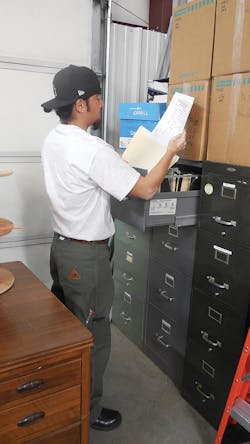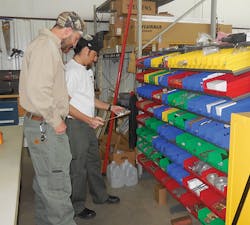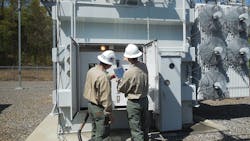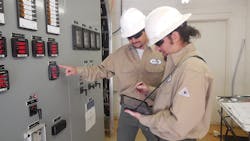Asset Management Approach Yields Savings
In 1903, the Wright Flyer took off from Kitty Hawk, North Carolina, U.S., and a pair of brothers demonstrated the viability of fixed-wing, powered aircraft. In describing the method used to improve the scientific design of their prototypes, Wilbur Wright said, “The best dividends on the labor invested have invariably come from seeking more knowledge rather than more power.”
The Wright brothers were proponents of data-driven decision making long before the term became trendy. Fast-forward to 2014, and the two-man substation team for Statesville, North Carolina, also had a vision for achieving something better using data.
With a population just under 25,000, the City of Statesville manages 10 substations and serves approximately 13,000 metered customers. Like many city-owned utilities, for a long time, records were kept on paper and historical data was in the heads of current staff. When conducting substation inspections, the inspector might get a piece of paper with a few handwritten questions, take a few readings, and either file the paper or, in later years, enter the readings into a spreadsheet back in the office. If the inspector came across a piece of equipment with an issue in the field, the fastest way to find out recent problems and fixes was to ask another employee.
There had to be a better way. If the Statesville utility’s substation team could eliminate duplicative data entry, simplify repetitive processes and create a remotely accessible, searchable database, the effect could be transformative for the city and its citizens. Instead of spending time dealing with equipment failures, the team could move to a proactive maintenance model, using data to identify potential issues and address aging parts before equipment reached the point of failure. Not only would this lead to more efficient workdays for the substation team, but it would reduce unplanned emergency repair expenditures as well as improve both reliability and the overall customer experience.
Searching for a Solution
In recent years, the Statesville utility’s substation staff had created an Excel-based tracking system to manage basic records and manually track problems. They wanted to eliminate paper records because they could be lost, physically damaged and deteriorate over time. Another issue with paper records was the challenge of trying to read and interpret someone else’s handwritten notes. Binders and files also were cumbersome and impractical. When investigating an issue at a substation, if specifics could not be recalled from memory, the inspector had to drive back to the office and dig through piles of paper to determine whether a component was under warranty, if the problem had come up before, and where spare parts might be stored.
The substation team knew products existed on the market to help track assets, automate workflow and simplify the inspection process. Many of the products were enormously powerful, with features designed for large utilities with millions of meters. Those products also came with substantial price tags. With a two-man substation management team, Statesville needed something flexible that would not force it to conform to multistage approval processes or create bureaucratic bottlenecks. The city needed something simple that would fit within its budget.
An ideal solution would allow customization, but commissioning a custom program was ruled out quickly. Custom products are expensive to develop and maintain. Plus, Statesville wanted to benefit from best practices, so a custom program would not be much of an improvement on the spreadsheet system the team had created and evolved on its own.
Over the years, the substation inspection process had become highly customized as the team learned about and improved data collection to capture the most important information. The team was deeply invested and committed to the process. This was not just a process on paper designed by consultants, but rather one the team perfected through hard work and direct experience. The employees wanted a solution that worked for them, not a big company that would insist they change their inspection process to fit the software.
One key concern was balancing what was useful with what was affordable. The team began researching and talking to vendors to see what was commercially available. Some vendors were ruled out because of cost or because their products — designed for the needs of much larger utilities — required more than Statesville had the capacity to handle.
The team lead came across MinMax Technologies, a company with extensive experience with both small- and large-scale database applications, a history in power delivery and a willingness to work with Statesville to tailor a solution to the city’s needs and budget.
Statesville Gets SMART
The inspection and asset management platform created by MinMax Technologies was called Substation Maintenance & Asset Reliability Tracking (SMART). Developed through work with Electric Power Research Institute (EPRI) member utilities, SMART’s library of equipment categories and inspection procedures aligns with those specified by the Institute of Electrical and Electronics Engineers (IEEE), Rural Utilities Service (RUS), North American Electric Reliability Corporation (NERC) and other regulatory agencies.
A cloud-based system, SMART runs through a secure third-party cyber center, with a mobile application that runs on any web-browser-enabled device. The substation team members would be able to use the off-the-shelf program on their iPads and laptops, connecting through stable, secure Wi-Fi , to access relevant data instantly, whether in the office or out in the field. By relying on the cloud and using mobile devices available at retail stores, the SMART deployment would minimize the impact on Statesville’s one-man IT department and could be scaled easily if the team made additional hires.
SMART Customization
For the Statesville utility, the highly customizable nature of SMART was key. The user-configurable libraries of equipment types, data fields, inspection questions and manufacturer information meant the substation team could create workflows and inventory databases that provided all the information the team wanted. Scaled appropriately to the size of the staff, this solution easily addressed one of the initial concerns that a commercial product would add complexity or bureaucracy to the team’s jobs rather than simplify them.
For the substation team, there was an early moment of surprise and amazement: Inspections could be tailored. They could set up inspection questions to match the process they were already using. Questions could be as short or as lengthy as the team wanted; there could be five items or 500. They could even preset answer choices to ensure data conformity. It gave the team members a boost of confidence to know they would not have to change their approach to inspections to accommodate the software.
Seeing Results
The team members also had an opportunity to provide feedback on features they would like to see added to SMART. The team wanted to track labor and costs by project to better understand how time and money were being spent. The ability to tie projects to budgets would help to justify spending during budget planning and discussions. By analyzing inspection data trends, the team could identify needs for increased maintenance or equipment replacement in the following fiscal year and budget accordingly.
Tracking time also was part of the larger plan to move to a proactive maintenance model. Without tracking, it was hard to know the actual time spent on different activities. Team members felt much of their time was spent dealing with unplanned and emergency repairs followed by daily, routine activities; however, feelings and data are not the same thing. It turned out SMART originally included project tracking and the ability to associate work orders with projects. The first few customers said this was not a valuable feature for them, so it was removed. Once the feature was restored, the substation team quickly implemented project tracking for both time and costs.
Occasionally, a team member would need to make minor purchases of supplies or special tools using a credit card. When submitting receipts — unless the staff member was asked what project the purchase was made for, and assuming he could remember on the spot — the costs were not associated with projects. Now by entering purchases made on employee credit cards into SMART, each purchase can be tied to a project and reports can be run to show spending by individual or by project. Another pleasant surprise, credit card use for supplies not in inventory was significantly lower than originally estimated. Actual spending was roughly half of projections.
The team quickly saw results in terms of savings on labor. If asked for averages on regulator taps, the team can now call up the data in seconds. Previously, this time-intensive task would require someone to look up individual values and analyze them. Breaker loading history is immediately accessible and can be viewed in terms of trends or historical use. Under the old spreadsheet system, someone would have had to sit down and build a new spreadsheet to evaluate the data. Procedural efficiencies improved both the speed of access and accuracy of data modeling.
The ability to view data instantly and access equipment records also has increased productivity, reduced back-and-forth trips and improved troubleshooting. Team members no longer have to rely on their memories to recall contractor information or when a particular piece of equipment was last serviced. When looking up a specific piece of equipment, SMART shows all relevant schematics, warranties, contractor information and maintenance history.
Troubleshooters also can look at similar pieces of equipment that have had the same issue, making it easier to determine root cause. Time that previously would have been spent looking for paperwork or running diagnostics quickly adds up. The substation team estimates a single employee now saves about four hours of time each week because of efficiencies. By the end of the month, that is 16 hours of saved time for just one employee, or like finding two extra workdays every month.
Building for the Future
In the first year of implementing SMART, the substation team focused on building out the database and gaining a thorough understanding of how the tools could be tailored to meet the team’s needs. As the team members used the platform, they would fill in database gaps or uncover new data that would be useful to track. The long-term vision for SMART is team members at a substation would have, at their fingertips, all the necessary information ¾ from plans, photos and manufacturer information to documentation forms and service history ¾ to finish a job and complete all necessary documentation in a single stop.
Recently, the utility hired a new substation team member and saw an immediate payoff in reduced training time for the newest employee. Because records were digitized and easily accessible, the newest member could work independently because he did not have to chase down other team members to ask about maintenance history or warranties. The electronic inspection process ensured the newest inspector would not forget steps or lose paperwork.
With the combination of a cloud-based tool and an additional employee, the utility’s substation team has created time for proactive maintenance. The substation team manages all work in-house, so savings came in the form of more efficient use of internal resources and cost avoidance. By moving to a proactive maintenance model, the team has improved customer service and increased reliability. By planning for equipment maintenance and replacement, the team avoids costly emergency purchases as well as potential regulatory fines and legal fees. Because work orders now provide an alert when a piece is under warranty, the team can make better use of warranties and avoid unnecessary purchases.
As the Wright Brothers before them, Statesville’s two-man substation team had a vision for a better way to do things. By moving from paper to electronic systems, the team members changed their approach to maintenance and created a sustainable, scalable program that can grow with their team. ♦
Keith Courson is a substation supervisor for the City of Statesville, an electric utility in North Carolina. He has supervisory and budgetary oversight for the department.
Billy Lara is a substation specialist for the City of Statesville. He has nine years of experience in electric distribution.
About the Author
Keith Courson
Substation Supervisor
Keith Courson is a substation supervisor for the City of Statesville, an electric utility in North Carolina. He has supervisory and budgetary oversight for the department.





